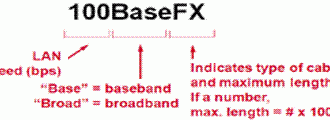FDDI is an American National Standards Institute (ANSI) standard that defines a dual Token Ring LAN operating at 100 Mbps over an optical fiber medium. It is used primarily for corporate and carrier backbones.
Token Ring and FDDI share several characteristics including token passing and a ring architecture which were explored in the previous section on Token Ring. Copper Distributed Data Interface (CDDI) is the implementation of FDDI protocols over STP and UTP cabling. CDDI transmits over relatively short distances (about 100 meters), providing data rates of 100 Mbps using a dual-ring architecture to provide redundancy.
While FDDI is fast, reliable, and handles a lot of data well, its major problem is the use of expensive fiber-optic cable. CDDI addresses this problem by using UTP or STP. However, notice that the maximum segment length drops significantly.
FDDI was developed in the mid-1980s to fill the needs of growing high-speed engineering workstation capacity and network reliability. Today, FDDI is frequently used as a high-speed backbone technology because of its support for high bandwidth and greater distances than copper.
FDDI Network Architecture
FDDI uses a dual-ring architecture. Traffic on each ring flows in opposite directions (called counter-rotating). The dual-rings consist of a primary and a secondary ring. During normal operation, the primary ring is used for data transmissions, and the secondary ring remains idle. The primary purpose of the dual rings is to provide superior reliability and robustness.
One of the unique characteristics of FDDI is that multiple ways exist to connect devices to the ring. FDDI defines three types of devices: single-attachment station (SAS) such as PCs, dual attachment station (DAS) such as routers and servers, and a concentrator.
– Dual-ring architecture
- – Primary ring for data transmissions
- – Secondary ring for reliability and robustness
– Components
- – Single attachment station (SAS)—PCs
- – Dual attachment station (DAS)—Servers
- – Concentrator
– FDDI concentrator
- – Also called a dual-attached concentrator (DAC)
- – Building block of an FDDI network
- – Attaches directly to both rings and ensures that any SAS failure or power-down does not bring down the ring
Example:-
An FDDI concentrator (also called a dual-attachment concentrator [DAC]) is the building block of an FDDI network. It attaches directly to both the primary and secondary rings and ensures that the failure or power-down of any single attachment station (SAS) does not bring down the ring. This is particularly useful when PCs, or similar devices that are frequently powered on and off, connect to the ring.
– FDDI Summary –
– Features
- – 100-Mbps token-passing network
- – Single-mode (100 km), double-mode (2 km)
- – CDDI transmits at 100 Mbps over about 100 m
- – Dual-ring architecture for reliability
– Optical fiber advantages versus copper
– Security, reliability, and performance are enhanced because it does not emit electrical signals
– Much higher bandwidth than copper
– Used for corporate and carrier backbones
– Summary –
- LAN technologies include Ethernet, Token Ring, and FDDI
- Ethernet
- Most widely used
- Good balance between speed, cost, and ease of installation
- 10 Mbps to 1000 Mbps
- Token Ring
- Primarily used with IBM networks
- 4 Mbps to 16 Mbps
- FDDI
- Primarily used for corporate backbones
- Supports longer distances
- 100 Mbps

